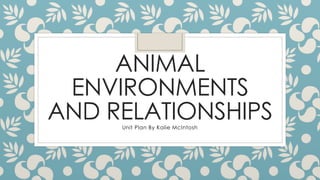Animal environments and relationships unit plan pp ci 350
- 1. ANIMAL ENVIRONMENTS AND RELATIONSHIPSUnit Plan By Kalie McIntosh
- 2. Analyze Learners ŌŚ” This is a third grade class. It consists of 7 girls and 8 boys. Two kids in the class have mild autism and use a behavioral color block system. The entire class is English Speaking and for the most part they all have about the same amount of scientific content knowledge, though there are some slight variations.
- 3. Main Objective ŌŚ” My students will investigate animal adaptions and be able to recognize that different organisms survive in different ways in different ecosystems. After researching information, designing a presentation, and working on interactive SmartBoard games. By the end of the six week unit with 80 % accuracy. ŌŚ” Assessment: I will be assessing their work throughout the unit. They will have a report outline graded with a rubric. Their report will be graded. Their presentation proposal will be graded. The summative assessment will be the video presentation they will present to the entire third grade at the end of the unit.
- 4. Day by Day Breakdown ŌŚ” Day 1: Discuss what living things need to survive, and work on a SmartBoard Activity/Game that has students decide what certain animals need and what they can live without. ŌŚ” Day 2: Introduce students to the term habitat. Define this and show examples and have students come up with examples in small groups. Each group will be given a large sticky note and they will write down different characteristics of habitats, these notes will then be displayed on the white board for the groups to compare and contrast. ŌŚ” Day 3: Read the students the book Weird Friends by Jose Arguego and Ariane Dewey and have them write a paragraph about two animals that help each other survive. Then bring up a diagram of a food chain on the Elmo to show them how a food chain works. ŌŚ” Day 4: Introduce students to the terms endangered and extinct. Have each group research a certain endangered species and develop an informal presentation to share with the rest of the class. ŌŚ” Day 5: Start working on video presentation that will be presented to the entire third grade at the end of the unit.
- 5. Technology ŌŚ” SmartBoard ŌŚ” Internet ŌŚ” Elmo projector ŌŚ” Markers
- 6. Works Cited ŌŚ” http://nextgenscience.org/search-standards ŌŚ” Weird Friends by Jose Arguego and Ariane Dewey





